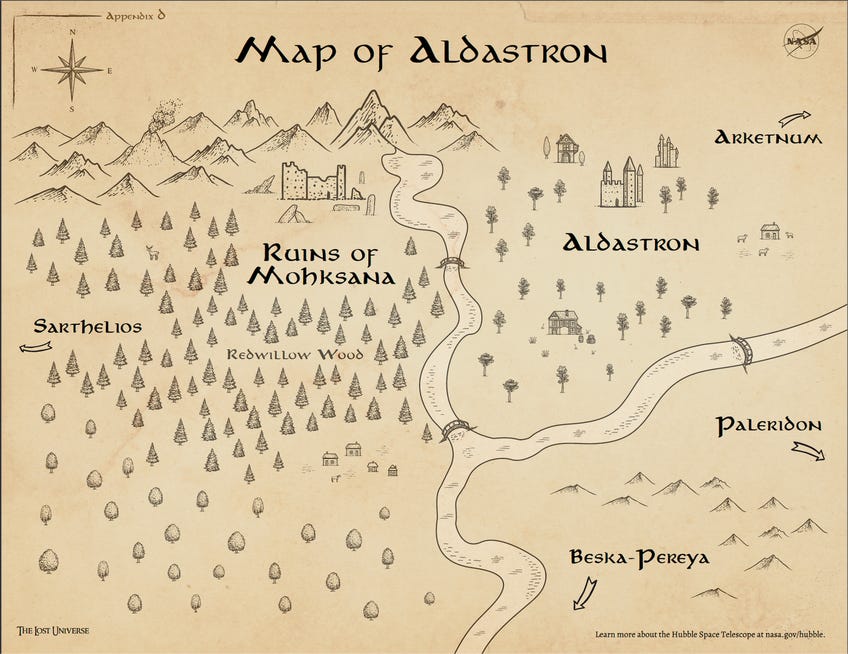NASA (yes, that NASA) has released its first D&D-compatible tabletop RPG adventure
Science and magic meet to solve the mystery of the missing Hubble Telescope
In a turn of events that makes a lot more sense than you might think at first blush, the National Aeronautics and Space Administration (NASA) just published a 5E-compatible tabletop RPG adventure about saving the Hubble Space Telescope.
The Lost Universe adventure was designed by Christina Mitchell, senior production specialist at the NASA Goddard Space Flight Center in Maryland, and is a 43-page romp through Aldastron, a fantasy city on the rogue planet of Exlaris. According to NASA’s website, both astronomical researchers and the Hubble Space telescope have abruptly disappeared, and it’ll take a band of intrepid adventurers to uncover the mystery.
It’s no more nerdy than your standard prewritten adventure for Dungeons & Dragons, but the transposition of a storied astronomy tool with the tabletop game synonymous with Freaks & Geeks for decades is genuinely hilarious - the sort of activity bored high school students whip up in between their AP classes and extracurriculars.
Let’s give The Lost Universe, which is available for free as a digital download, a fair shake. Designed for four to seven players piloting characters at least level 7, the whole thing should fill a single 4-hour session. Interestingly, the premise uses the popular isekai anime premise of diegetically throwing the players into the bodies of fantasy denizens - they have all the real-world knowledge their players do but must operate in a faux medieval reality.
Mitchell has invested an impressive amount of worldbuilding, explaining that the rogue planet developed what they call magic by developing “the ability to harness the energy of the vacuum, the energy filling the universe around them,” and when a black hole slingshot Exlaris into the void of space, the wizards of that world averted total catastrophe by creating a stable barrier around the entire planet.
Society rebuilt from the chaos and established five major cities, each with its own particular astronomical research focus from astrophysics and biological systems to solar science and aeronautics. There’s an earnest love of both D&D’s style of storytelling and the melange of hard sciences that would spur someone into working for NASA. Even as I smile at the unadulterated nerd-ness of The Lost Adventure, I recognise and respect my own urge to funnel every special interest into a creative endeavor like this.

As if that wasn’t enough, the appendices are chockablock with images captured by Hubble and other telescopes portraying the universe’s beauty, along with a bisected diagram of the telescope and plenty of links to NASA web pages explaining vacuums, dark matter, gravitational lensing and so much more. You then scroll past the biographies for Nancy Grace Roman and Edwin Hubble to find a sepia-toned map of the adventure’s setting, complete with little tree and mountain icons. Unreal stuff, and I love it so much.
Nothing in the adventure’s design ties it to D&D 5E’s rules, so your group could run The Lost Universe with any tabletop RPG ruleset that can handle skills tests, puzzles and dialogue-heavy roleplay. It’s a clever bit of marketing given D&D’s current pop culture ubiquity, and while it’s not as impressively produced or designed as what you might purchase on DriveThruRPG or the DMs Guild, tell me which other national aeronautics is out here encouraging you to roll dice?
Mitchell is joined by graphic designer Michelle Belleville and a team of editors and developers: Kenneth Carpenter, Katy Cawdrey, Rob Garner, Karl Hille, Peter Jacobs, Jim Jeletic, Esben Jepsen, Paul Morris, Gage Taylor, Elizabeth Tammi, Lauren Ward. All of the game files can be downloaded from NASA’s Hubble website, which include the adventure PDF, a map and a poster.










